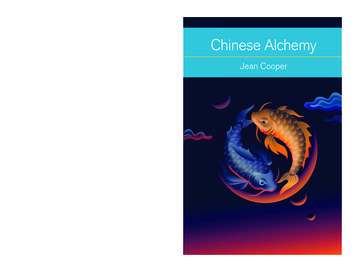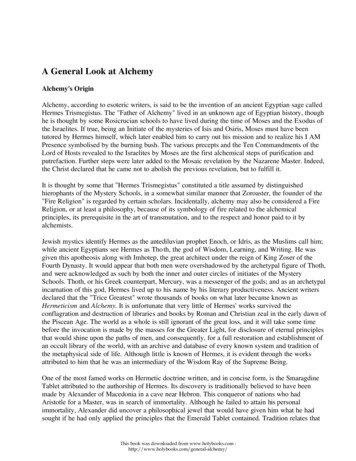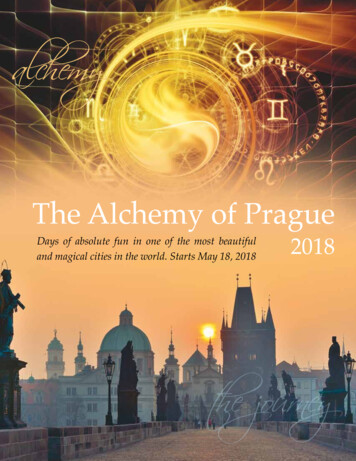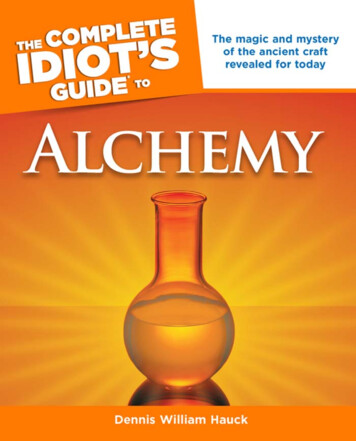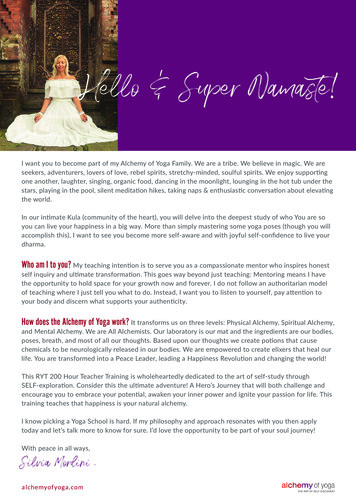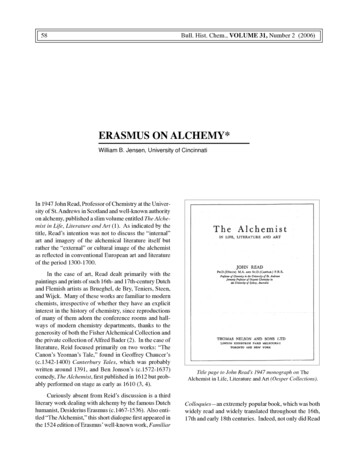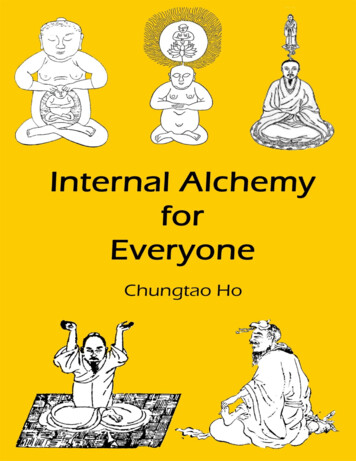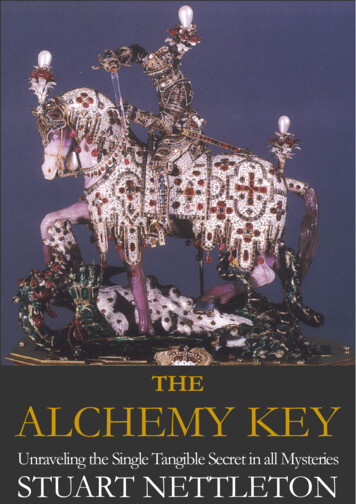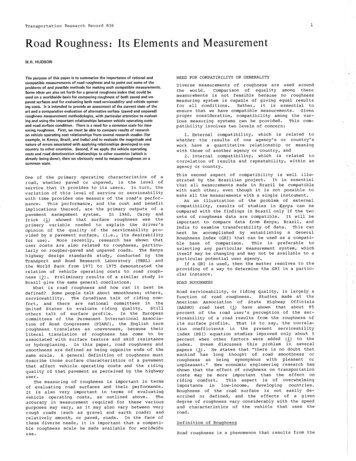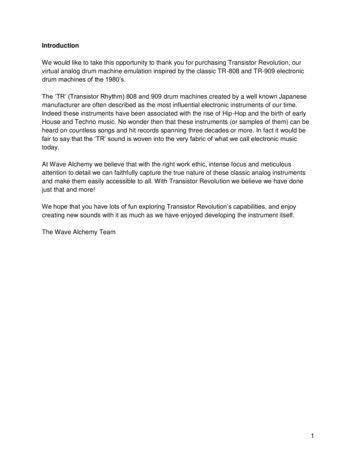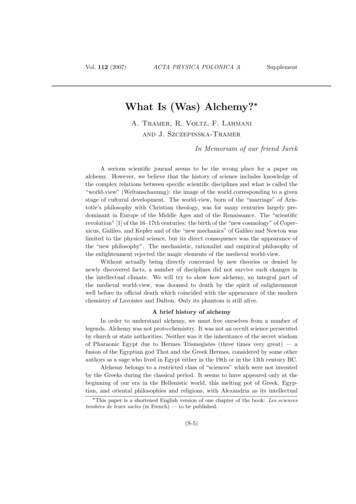
Transcription
Vol. 112 (2007)ACTA PHYSICA POLONICA ASupplementWhat Is (Was) Alchemy? A. Tramer, R. Voltz, F. Lahmaniand J. Szczepinska-TramerIn Memoriam of our friend JurekA serious scientific journal seems to be the wrong place for a paper onalchemy. However, we believe that the history of science includes knowledge ofthe complex relations between specific scientific disciplines and what is called the“world-view” (Weltanschauung): the image of the world corresponding to a givenstage of cultural development. The world-view, born of the “marriage” of Aristotle’s philosophy with Christian theology, was for many centuries largely predominant in Europe of the Middle Ages and of the Renaissance. The “scientificrevolution” [1] of the 16–17th centuries: the birth of the “new cosmology” of Copernicus, Galileo, and Kepler and of the “new mechanics” of Galileo and Newton waslimited to the physical science, but its direct consequence was the appearance ofthe “new philosophy”. The mechanistic, rationalist and empirical philosophy ofthe enlightenment rejected the magic elements of the medieval world-view.Without actually being directly concerned by new theories or denied bynewly discovered facts, a number of disciplines did not survive such changes inthe intellectual climate. We will try to show how alchemy, an integral part ofthe medieval world-view, was doomed to death by the spirit of enlightenmentwell before its official death which coincided with the appearance of the modernchemistry of Lavoisier and Dalton. Only its phantom is still alive.A brief history of alchemyIn order to understand alchemy, we must free ourselves from a number oflegends. Alchemy was not proto-chemistry. It was not an occult science persecutedby church or state authorities. Neither was it the inheritance of the secret wisdomof Pharaonic Egypt due to Hermes Trismegistes (three times very great) — afusion of the Egyptian god Thot and the Greek Hermes, considered by some otherauthors as a sage who lived in Egypt either in the 19th or in the 13th century BC.Alchemy belongs to a restricted class of “sciences” which were not inventedby the Greeks during the classical period. It seems to have appeared only at thebeginning of our era in the Hellenistic world, this melting pot of Greek, Egyptian, and oriental philosophies and religions, with Alexandria as its intellectual This paper is a shortened English version of one chapter of the book: Les sciencestombées de leurs socles (in French) — to be published.(S-5)
S-6A. Tramer et al.capital. The set of fifteen manuscripts on alchemical, magic, and religious gnosticdoctrines attributed to Hermes Trismegistes, known as the corpus hermeticum [2]and the famous tabula smaragdina (emerald tablet), considered as the summaryof all alchemic wisdom, were written between 200 and 300 AD.After the fall of the Latin Empire, alchemy was practically forgotten in Western Europe and even in Byzantium. In contrast, in the Islamic, Arabian–Persianworld alchemy was rediscovered and developed in close relation with metallurgyand medicine. It came back to Western Europe in the 10–12th centuries, mainlythrough the Spain “of three religions”. Evidence of this path lies in the large number of Arabic words, such as elixir, alembic, or athanor, in alchemical terminologyand the deformed names of Islamic scholars in Latin mediaeval manuscripts: Jabiribn Hayyan (Geber) 720–780, al-Razi (Rhazes) 850 940, ibn Sina (Avicenna)980–1030 and al-Tohgrai (Artephius) ?–1120.In the late Middle Ages (12–14th centuries), alchemy was studied by sucheminent personalities as Albertus Magnus — Albert von Bollstädt (1193–1280),professor of philosophy and theology at the Universities of Cologne and Paris, orArnaldus de Villanova (1235–1313), rector of Montpellier University. The alchemical treatise Aurora Surgens was attributed to Thomas Aquinas (1226–1275).Alchemy attained the summit of its career during the Renaissance andBaroque years (1350-1650). It had its place at royal courts, the most famous beingthat of Emperor Rodolph II (1576–1612) in Prague, but also that of Philip II ofSpain (1556–1598). It was protected by the popes. The attitude of the Reformerswas also favourable, as shown by this remark by Martin Luther reported in hisTable talks [3]:The science of alchymy I like very well, and indeed, ’tis the philosophy of theancients. I like it not only for the profits it brings in melting metals, in decocting,preparing, extracting and distilling herbs, roots; I like it also for the sake of theallegory and secret signification, which is exceedingly fine, touching the resurrectionof the dead at the last day.Alchemy was in excellent agreement with the intellectual climate of Renaissance Europe which was characterised by unlimited curiosity, a taste for adventurous enterprises and, as the other side of the coin, an absence of criticism whichled to superstitious beliefs in magic and witchcraft. Its view of Nature is that ofMagia naturalis, of mysterious forces acting between all the material and spiritualbeings of the world [4].The decline of alchemy in the 18th century Europe was due to two factorswhich will be discussed later: its conflict with the rational and critical philosophyof the enlightenment and the dawning of modern chemistry. It almost disappearedwhen chemistry became a science.Principles of alchemyAs far as alchemical studies are concerned, we have at our disposal a richlibrary of manuscripts and books printed during the 15th to 17th centuries. They
What Is (Was) Alchemy?S-7are catalogued in Jung’s book Psychology and Alchemy and on web sites suchas http://www.levity.com/alchemy or http://www.hdelboy.fr/plan alchimie. Theauthors of some of these books are known, others are anonymous. Many of thebooks were attributed to such famous personalities such as Hermes Trismegistes,Plato, Democritus or St. Thomas Aquinas in order to increase their prestige.Thus, 486 (sic!) alchemic treatises were attributed to Ramon Lull (1235–1315),one of the great medieval scholars.Among these texts, we must mention the Corpus hermeticum brought toWestern Europe from Greece in the XIV century, translated into Latin by theFlorentine humanist Marcello Ficino and printed already in 1462, and the famousEmerald tablet (Tabula smaragdina) alleged to contain the secretum secretorum ofalchemy. As an example of hermetic language, we reproduce here a translation ofthe Tablet into 17th century English by the famous alchemist . . . Isaac Newton [5]:1) Tis true without lying, certain & most true.2) That wch is below is like that wch is above & that wch is above is like ye wch isbelow to do ye miracles of one only thing.3) And as all things have been & arose from one by ye mediation of one: so allthings have their birth from this one thing by adaptation.4) The Sun is its father, the moon its mother,5) the wind hath carried it in its belly, the earth its nourse.6) The father of all perfection in ye whole world is here.7) Its force or power is entire if it be converted into earth.7a) Seperate thou ye earth from ye fire, ye subtile from the gross sweetly wth greatindoustry.8) It ascends from ye earth to ye heaven & again it desends to ye earth and receivesye force of things superior & inferior.9) By this means you shall have ye glory of ye whole world & thereby all obscurityshall fly from you.10) Its force is above all force, for it vanquishes every subtile thing & penetratesevery solid thing.11a) So was ye world created.12) From this are & do come admirable adaptations whereof ye means (Or process)is here in this.13) Hence I am called Hermes Trismegist, having the three parts of ye philosophyof ye whole world.14) That wch I have said of ye operation of ye Sun is accomplished & ended.Alchemic treatises are full of comments giving different and contradictoryinterpretations of the mystery of the Tablet. The obvious conclusion is that weare dealing with something more than a mere description of technical procedures:a magical, esoteric philosophy closely related to proto-chemical “technology”. Itstwo faces, “material” alchemy and “spiritual” alchemy, are inseparable. We will,nevertheless, be obliged to describe these two faces one after the other.
S-8A. Tramer et al.Material alchemyOne of the key principles of alchemy is the possibility of transmutation ofnatural substances and, in particular, the transformation of ordinary (base) metalsinto silver or gold. This project looks absurd to anybody thinking in terms of theatomic structure of chemical elements and compounds, but it was compatiblewith the image of the material world elaborated by the ancient philosophers andconfirmed by the every-day experience of the pre-industrial society.For Aristotle [6], matter (hyle), inert and shapeless by itself, gained its shapeand properties by the action of form (morphe) which could be expressed by suchfactors as hot, cold, dry and humid, giving in turn, by their combination, fourelements: earth (cold and dry), water (cold and humid), air (hot and humid) andfire (hot and dry). The elements were eternal and indestructible and by synthesis(chemical reaction), mixis (mechanical mixing) or krasis (dissolution) gave birthto different substances whose properties depended solely on the contents of eachelement. This idea, essential for all of Aristotle’s physics was expressed by Empedocles in a beautiful metaphor [7]: And as when painters . . . take many-colouredpigments to work with, and blend together harmoniously more of one and less ofanother till they produce likenesses of all things; so let not error overcome thy mindto make thee think there is any other source of mortal things that have likewisecome into distinct existence in unspeakable numbers; but know these (elements),for thou didst hear from a god the account of them.It followed that, if the metals differed only by their composition, with theproper treatment it had to be possible to transform any base metal into silverand gold. The ancient blacksmiths (metallurgists) knew that grey or greenishearth (ore) mixed with fire gave a brilliant metallic copper and that the quality ofbronze could be improved by changing the copper content in copper–tin alloy. Sowhy not try to “improve” copper or lead in order to obtain pure gold?This kind of “improvement” was not in contradiction with natural laws. Thecurrent belief at that time was that metals hidden underground grew and improvedlike foetuses in the womb of their mother until they changed into gold [8]. Therole of alchemy was to accelerate this process by the quasi-catalytic action of thephilosophical stone.In modern (14th to 17th centuries) Western European alchemy, all metalswere described as a specific case of Aristotle’s four-element “theory”. This “model”was proposed by the Arabian alchemist Jabir ibn Hayyan (Geber) and was widelyused in alchemy and medicine by Paracelsus (T. von Hohenheim 1493–1541) andhis followers [9]. According to this model, all metals are composed of sulphur,mercury and salt, considered not as chemicals but as “essentials” which may begood (pure) or bad (impure). Mercury is responsible for their metallic characterand fusibility whereas sulphur determines their colour and inflammability. Salt isan impurity. Thus gold contains good mercury and good sulphur while in copper,mercury is good but red sulphur is bad. In order to transform copper into gold,
What Is (Was) Alchemy?S-9one must separate its essentials, purify sulphur and melt them together [10].The usual way to carry out such a transformation was by “synthesis” ofthe philosophical stone (Lapis philosophorum) which in spite of its name was notalways a solid, but could be either a liquid (elixir) or a powder. It is not obviouswhether Lapis and elixir are different names for the same product or two differentproducts. Lapis (elixir) projected onto the base metal would transform it into silveror gold and constituted a powerful medicine ensuring longevity or even immortalitywhen projected onto a man.The production of the Lapis (the Great Work — Opus magnum) is a longprocess involving a number of steps (three to twelve according to different sources)described in different ways by different authors. In order to prepare the Lapis, thesubstrate must be submitted to a whole series of operations, their general rulebeing: solve et coagula — divide and bring together. The substrate (materia) wasusually a mineral, stibine (antimony sulfide Sb2 S3 ) or cinnabar (mercury sulphideHgS), but metals or organic compounds were also applied. For further treatmentone could choose either the humid or the dry way. In the first case, the substratewas mixed with corrosive substances (acids, ammonium chloride) in a ceramiccontainer (philosophical egg or aludel) and heated in a furnace (athanor). In thelatter case, the mixture was melted in a crucible put in the flame.The aim of the whole work was to separate solid and volatile fractions ofthe materia prima, purify each of them and then bring them together. In mostrecipes, one can differentiate three stages in the process characterized by threecolours: black, white and red.— the first of them — the work in black (nigredo) represented by the head ofa raven corresponds to the “death” of the materia (calcinatio) followed byseparation (putrefactio) of its different fractions.— the work in white (albedo) consists of the purification (solutio) and separationof the purified components (distillatio). The shining white matter may beused for the transmutation of metals into silver.— the final stage — the work in red (rubedo) involves the reunification of theseparated and purified components (coniunctio oppositorum). The matterbecomes multicolour (this step is called rainbow or peacock tail) and thenturns to red. The last step is the triumph (sublimatio) indicating the formation of the Lapis, the symbol of which is a hermaphrodite.This is the basic scheme of the work but important deviations from thisscheme are current in the alchemic recipes.Spiritual alchemyThe purpose of the alchemic operation (Opus alchymicum) is much moreambitious than a simple chemical reaction. In any case, in the world of alchemy,all parts of the universe are so strongly interrelated that everything can influence
S-10A. Tramer et al.and be influenced by everything else. Each human action to some extent modifiesthe whole world. In medieval theology, the earth (and not only human nature)is corrupted by the Original Sin of the first parents; this conviction was based onseveral statements contained in Genesis [11]:cursed is the ground for thy sake; in sorrow. . . ; thorns also and thistles shallit bring forth to theeand in the letters of St. Paul [12]:For the earnest expectation of the creature waiteth for the manifestation ofthe sons of God. For the creature was made subject to vanity, not willingly, butby reason of him who hath subjected the same in hope. Because the creature itselfalso shall be delivered from the bondage of corruption. . .The aim of the Opus is to restore the initial health of nature, and the goldobtained in this operation is just a sign, a symbol of this “resurrection”. Manyalchemic texts insist on the analogy between Lapis philosophorum and Christ theRedemptor. Since the relation between Lapis and the alchemist is particularlystrong, the success of the Opus transforms a simple craftsman (artifex) into aninitiate (adept). According to Michael Maier [13], our chemistry stirs up the artifexto a meditation of the heavenly good. . . so that . . . he feels himself as it were newborn. In close contact with the Lapis, the body and the soul of the adept acquirethe “quality of gold”.Because of the strength of interrelation between the different parts of theuniverse, the success of the Opus in turn depends on the positions of the starsand planets at different stages in the operation, but also on a large number offactors which are not known. Because of these unknowns, the success or failure ofthe project cannot be predicted. From this point of view, the Opus is completelydifferent from the scientific experiment, which is supposed to be reproducible inunchanged conditions.Obviously, the moral factor, the purity of the alchemist’s soul, is the essential condition for the realization of the work; religious and spiritual exercise isthus necessary and, for this reason, the alchemist’s laboratory usually contains anoratory with an altar for ritual prayers.Rosarium PhilosophorumInstead of a review of different alchemical treatises, we prefer here to make abrief presentation of one of them, the famous Rosarium Philosophorum attributedto Arnaldus de Villanova and published in Frankfurt/Main in 1550. Rather thanthe original, we will discuss its summary Collectanea Lacinii [10] (all quotationsare taken from it) and focus our attention on the set of 20 beautiful engravingsdiscussed by Jung [14], McLean [15], and Voss [16]. They illustrate the “material”Opus of extraction of the Lapis from gold and silver by a story involving theSolar King and the Lunar Queen. It must be kept in mind that, in the world-view of Magia naturalis, close relations existed between metals and “planets”,
What Is (Was) Alchemy?S-11the sun being closely related to gold and the moon to silver. According to theEmerald tablet: The Sun is its father, the Moon its mother. In one of the firstengravings, we see the King and Queen accompanied by a dove, which plays therole of intermediary in the Opus (Fig. 1).Silver and gold are dissolved in mercury: because bodies when dissolved become spiritual. . . the solution of the body means coagulation of the spirit. Thisaction is represented by the bathing of the Royal Couple in the philosophical fountain. In contrast to the current scheme, Coniunctio sive Coitus, represented bytheir sexual embrace (Fig. 2), takes place at the beginning and is followed by thepurification of the black body corresponding to the nigredo stage and representedby the Couple merged into one body with a single crown (Fig. 3) and apparentlydead (conceptio sive putrefactio). The black body is then divided into solid andvolatile parts and purified by a series of operations for the removal of all that isblack, corrupt and fetid. . . These are defined as follows: Solution is of the grossinto the subtle. Purification is of the dark into the bright, Reduction is of thehumid into the dry. . . and so on. Purification is represented in the next figures(Figs. 4 to 6), showing the King’s soul rising to heaven, the rain washing the bodiesand the soul returning from the clouds to join and resuscitate the double body. Afurther symbol is the death and resurrection of the dove, shown in the bottom ofFig. 6. The result of these operations is the white elixir (albedo) represented bythe naked, winged lunar hermaphrodite standing on the crescent moon betweenthe lunar tree and the dove (Fig. 7).
S-12A. Tramer et al.The whole operation is then repeated in a slightly modified way and therubedo stage is reached: the solar hermaphrodite (the child of the work), in ceremonial dress, is surrounded by the solar tree, the lion and the pelican, symbol ofthe charity (Fig. 8). The last figure represents the resurrection of Christ, a clearreference to the Christ — Lapis analogy.Rosarium shows how close the relation is between the techniques of materialalchemy and the philosophy of spiritual alchemy.
What Is (Was) Alchemy?S-13Alchemy as science — alchemy as magicThe technology of material alchemy is not essentially different from chemicalpractice and some of the by-products of alchemical experiments constitute important discoveries. One can thus wonder whether alchemy was anything other thanthe early stage of development of chemical science.From the beginning of this paper, we have laid stress on the perfect agreement between material alchemy and the overall world-view originating from Aristotle’s physics and maintained until the scientific revolution of 16–17th centuries.In a world built by the mixing of the same four elements in different proportions,the transmutation of metals was quite a realistic project. It must be noted thatalchemy was never in competition with any other more rational theory or technique, it was as “scientific” as Aristotle’s physics and astronomy.There are, however, fundamental differences between alchemy and modernchemistry:— the modern chemist tries, as far as possible, to isolate the system understudy from the remaining parts of the world and to fix all the parameters inorder to get a quantitative answer which will confirm or deny his theory. Inthese conditions, the theory is falsifiable, which is the usual criterium of itsscientific status [17]. Such a criterium cannot be satisfied by the alchemistwho believes in the infinite chain of interrelations between all material andspiritual beings in the world so that it is impossible to isolate any fractionof it from the others.
S-14A. Tramer et al.— in view of the interrelations between the infinite number of processes occurring simultaneously in the universe, the conditions of an alchemic experiment cannot be defined and reproduced. The fundamental requirement ofexperimental science, that of the reproducibility of experiments performedin identical conditions, is therefore meaningless in the alchemic world. Evenwhen all experiments give negative results for many centuries, their failuredoes not mean that the theory is wrong. It means only that some mysteriousfactor was systematically but accidentally unfavourable when the previousoperations were attempted. The alchemist will thus repeat the same procedure many times in the hope that something will change in the universe sothat his next attempts will be successful. This hope will be further reinforcedif he believes that somebody in the past realized the Opus. No modern scientist would be so patient! He would certainly try to understand the reasonsfor his misfortune and would question the validity of his theory.— the modern chemist tries to define the area of validity of his theory deducedfrom an experiment involving a limited class of systems. The ambition ofthe alchemist is to formulate general laws which govern the whole universe.He believes in the analogy between the micro- and macro-cosmos which allows extrapolation of the results of his experiments to an extended class ofphenomena.— the alchemist considers himself as a part of the system under study so thatthe success of the Opus depends not only on its material parameters but alsoon the soul and spirit of the “operator”. In the modern methodology, the“operator” does not faithfully follow or accelerate the predetermined courseof Nature. He regards Nature as a simple “object” of his empirical andrational investigation.All these features — inseparability of material and spiritual factors, interrelationsbetween apparently non-related phenomena, analogy used as a logical argument,the operator as a part of the process under study — are characteristic of the world-view of magic and esoterism [18] and have no place in the scientific view of theworld. In spite of similar experimental techniques, alchemy and chemistry belongto two different intellectual formations.Decline of alchemyThe decline of alchemy in 18th century Europe is mainly due to its conflictwith the rationalistic, empirical philosophy of enlightenment. Mysterious interrelations between all parts of the world have no place in the mechanistic view of thematerial world introduced by Descartes and Gassendi. According to Jung [19]:Its method of explanation, obscurum per obscurius, ignotum par ignotius. . . wasincompatible with the spirit of enlightenment. . . but this conflict. . . only gave lecoup de grace to alchemy. Its inner decay began at least a century earlier . . . when
What Is (Was) Alchemy?S-15many alchemists deserted their alembics and melting pots and devoted themselvesentirely to the (Hermetic) philosophy. . . [which] lost the empirical ground under itsfeet and aspired to bombastic allegories and insane speculations. . .The bond between material and spiritual aspects of alchemy, essential forthe traditional world-view, was now broken. After this divorce, material alchemybecame proto-chemistry. There was no revolution and there were no importantdiscoveries: the ideas of modern chemical science germinated within the body ofalchemy as a re-interpretation of ancient knowledge. It is interesting to follow howthe first true chemical theory (wrong but important as a first step) was built: sulphur (one of three “essentials” of each metal in alchemy) was considered by JohannBecher (1635–1682) as “inflammable earth” and for Georg Stahl (1660–1734) became “phlogiston” — a component of each inflammable body lost when the body isburned. At the same time, the Skeptical Chymist (1661) by Robert Boyle containsthe first definitions of the chemical compound as opposed to mechanical mixtures.Nevertheless, alchemy resisted. Robert Boyle, one of the fathers of modernchemistry, was an alchemist and Isaac Newton spent more time reading alchemictreatises and performing alchemic experiments than on elaborating the whole ofNewtonian new physics [5]. Until the end of 18th century, the pioneers of “pneumatical chemistry” (Priestle, Cavendish, Scheele) classified the gases obtained inchemical experiments not as chemical elements or compounds but as modifications of the element Air: “air of fire” or “deflogisticated air” (oxygen), “nitrousair” (nitric oxide) or “inflammable air” (hydrogen).Alchemy disappeared when chemistry became a true science deducing general laws from quantitative measurements. Condemned to death as incompatiblewith this new science, alchemy survived in the margins of modern culture. Itfound asylum in esoteric sects such as the Rosicrucian movement and in the mystic tendencies of freemasonry until it reappeared as a part of the “post-modern”antiscientific trend of the 20th century.“Modern” alchemyAfter a long period of lethargy, interest in alchemy reappeared within themainstream of occultism and theosophy represented by Helen P. Blawatsky (1831–1891), founder of the Theosophical Society and, in France, by Albert Poisson(1865–1894) and Emile Grillot de Givry (?–1929), who published several books onthe history of occult sciences but also practiced material alchemy. Later still, amysterious person, whose real name has not been identified, published under thename of Fulcanelli the books about alchemic symbols in XV century churches andcastles: Le mystère des cathédrales (1926) and Les Demeures philosophales (1930).He claimed to be an adept who some centuries before had carried out the Opusmagnum and gained extraordinary longevity.Small groups of active alchemists still exist, have their web sites such ashttp://www.dmoz.fr and http://www.orifaber.com, their reviews (Chrysopeı̈a in
S-16A. Tramer et al.France) and their editors such as Arbre d’or, which recently published Traité del’Elixir by J. Nobs.Several representatives of the antimaterialistic tendencies in anthropology(Mircea Eliade) and psychology (Carl Jung and his followers such as Marie-Louisevon Frantz) returned to spiritual alchemy, to its philosophy and to its language.Under the charm of alchemy, some historians (such as Serge Hutin [20] and RenéAlleau [21] in France, for example) tried to convince themselves that several famousalchemists had succeeded in carrying out transmutation owing to their knowledgeof natural forces not known to the modern science.The discovery of nuclear reactions opened the gate to speculations about“nuclear alchemy” used by ancient adepts. Obviously, “nuclear transmutations”could not be realized with the technology at the disposal of alchemists, even ifthey can now be carried out on a microscopic scale. Let us give an example: asingle isotope of mercury, necessary for optical-pumping experiments, was prepared from gold by “reverse alchemy”, less expensive than the separation of Hgisotopes. Only one isotope of gold 79 Au197 is stable and yields in the reaction197(n,γ) 79 Au198 the β radioactive 198 gold isotope which decays with for79 Aumation of a single 80 Hg198 isotope of mercury. After six months’ irradiation of asample of gold in a nuclear reactor, 0.02% percent of its mass was transformed intomercury [22]. The efficiency of nuclear alchemy is much too low for any wider practical applications.It is interesting to note how the place occupied by alchemy in our modern world is restricted compared to that of astrology, which not only remains animportant component of the popular world-view but is also the object of serious investigations. This difference merits a detailed study, but it seems to us that one ofthe important reasons is the difference between the characters of the “orphans” leftafter the separation of the alchemy–chemistry and astrology–astronomy Siamesetwins. Chemistry was unable to produce the philosophical stone or the elixir ofimmortality, but its successes in the field of medicine and the invention of newproducts changing everyday life are highly appreciated. One can thus abandonalchemic dreams for chemical reality.On the other hand, the successes of astronomy and astrophysics are amazing,but their influence on the human condition is limited and they do not offer whatastrology promised to give, namely the knowledge of our character and of ourfuture. No scientific or pseudo-scientific discipline is able to replace astrology as afalse key (but still a key) to human souls and destinies.ConclusionWe have tried to show that alchemy was an integral part of the world-viewborn at the beginning of our era from the marriage between Christian theologyand Greek philosophy. Its philosophy of nature was a compound of scientific andmagic elements. This view was incompatible with the new world-image originating
What Is (Was) Alchemy?S-17from the scientific revolution of the 16–18th centuries which rejected the spiritualaspects of alche
S-6 A. Tramer et al. capital. The set of flfteen manuscripts on alchemical, magic, and religious gnostic doctrines attributed to Hermes Trismegistes, known as the corpus hermeticum [2] and the famous tabula smaragdina (emerald tablet), considered as the summary of all alchemic wisdom, were written between 200 and 300 AD.
